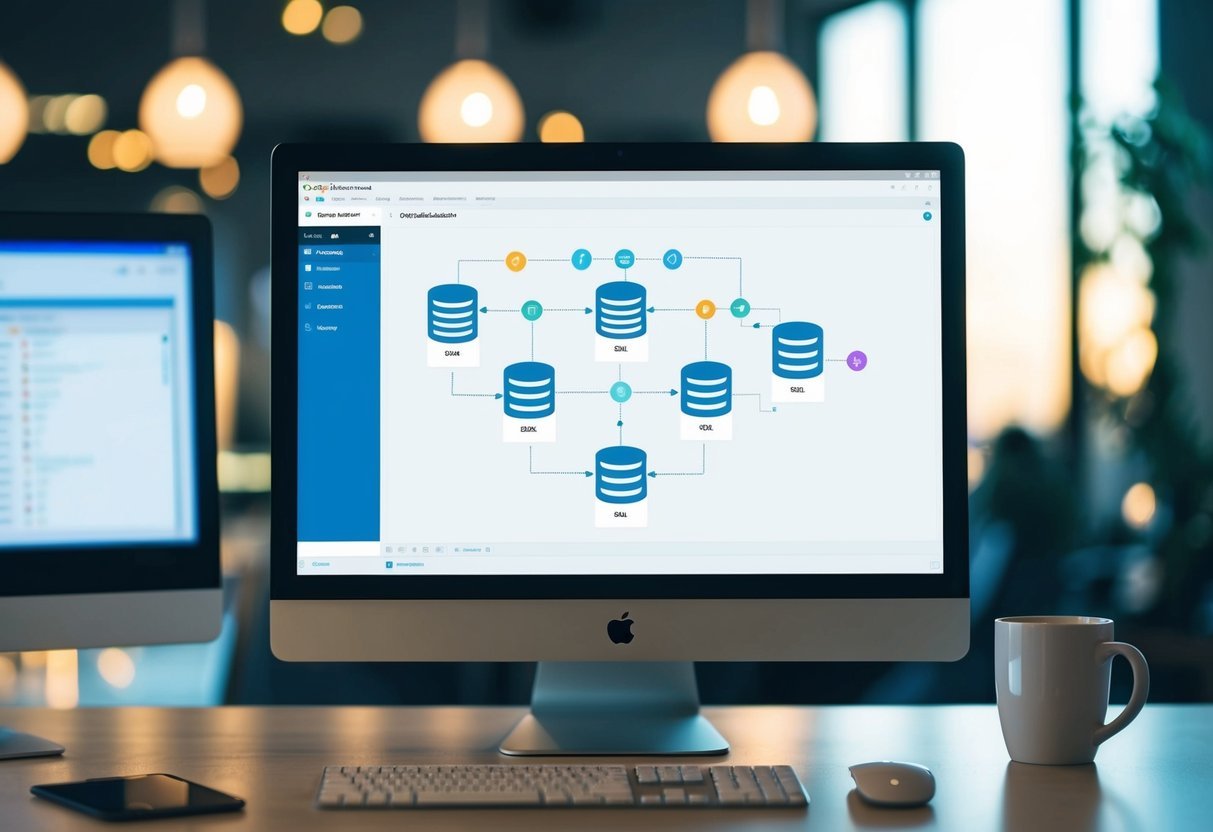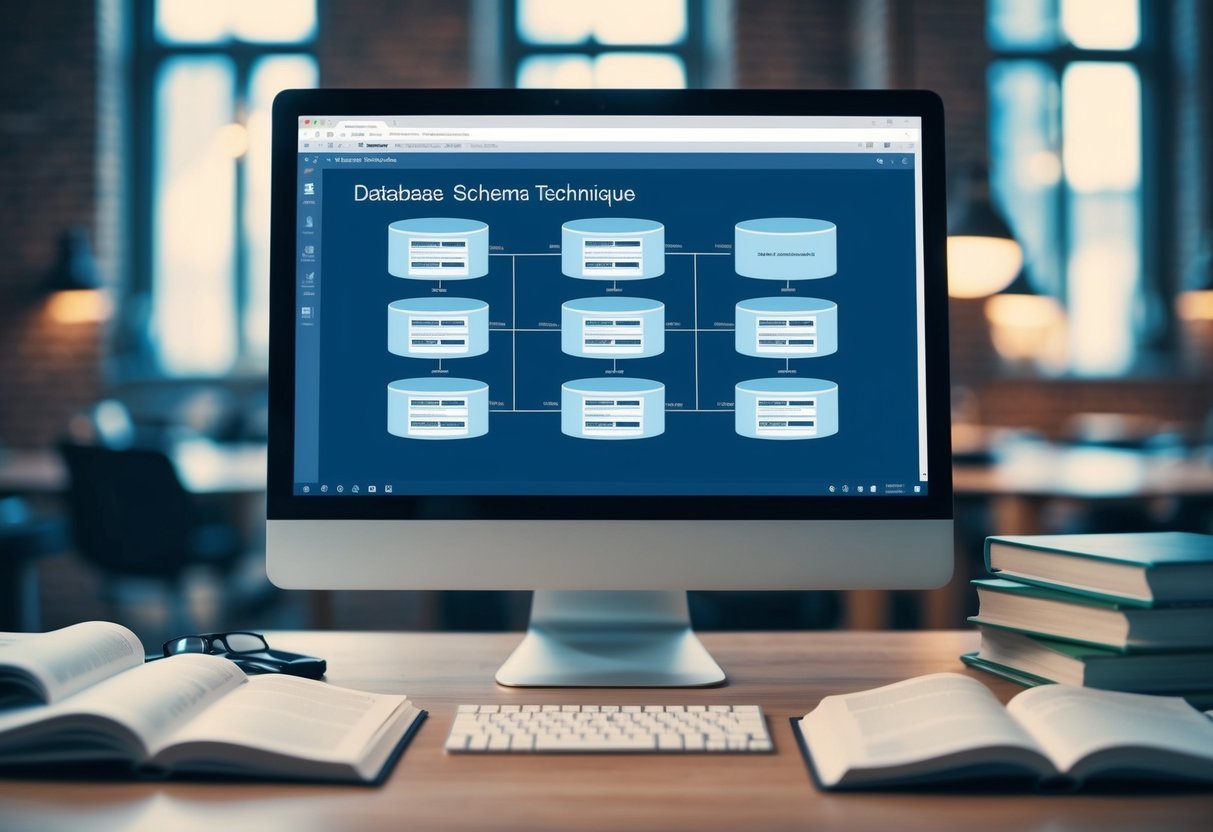Understanding SQL and Aggregate Functions
SQL is a powerful language used to manage and analyze data in relational databases. It allows users to retrieve, update, and manipulate data stored in tables.
One crucial feature of SQL is its ability to perform complex calculations using aggregate functions.
Aggregate functions are tools in SQL that perform a calculation on a set of values and return a single result. They are often used alongside the GROUP BY clause, which groups data based on one or more columns.
Here’s a brief overview of common SQL aggregate functions:
- COUNT(): Counts the number of rows in a specific column.
- SUM(): Adds up all the values in a column.
- AVG(): Calculates the average of a set of values.
- MIN() and MAX(): Return the smallest and largest values in a column, respectively.
These functions are essential for summarizing data efficiently. They help transform raw data into meaningful insights, like calculating total sales or average scores. To learn more about how these functions work, refer to this SQL Aggregate Functions guide.
Getting Started with GROUP BY Clause
The GROUP BY clause in SQL is essential for organizing and summarizing data within tables. It is often paired with aggregate functions like COUNT() or SUM() to analyze datasets effectively.
The Role of GROUP BY in Data Aggregation
In SQL, the GROUP BY clause is used to group rows that have the same values in certain columns. This helps in creating summary rows for the data, which is crucial in data analysis.
By using GROUP BY, one can categorize data within a table, making it easier to apply aggregate functions.
Aggregate functions like COUNT(), AVG(), MIN(), and MAX() are often applied to these grouped datasets. For example, in a table of sales data, one might use GROUP BY to calculate the total sales per product category. This technique highlights patterns and insights that are not readily apparent in raw data. Consequently, mastering the GROUP BY clause is valuable for anyone looking to effectively analyze SQL data.
Utilizing Aggregate Functions in Queries
Using aggregate functions in SQL queries helps to summarize and calculate valuable information from data. These functions, such as SUM, AVG, and COUNT, are often used with the GROUP BY clause to provide insights into datasets by organizing data into meaningful groups.
Functions for Calculating Totals and Averages
To calculate totals, the SUM() function is essential. It adds up all values in a column. For example, in a sales database, SUM() can be used to find the total sales revenue.
On the other hand, the AVG() function calculates the average value of a column. It is particularly useful in situations like finding the average salary of employees.
Both functions can be combined with GROUP BY to obtain totals and averages for specific groups. For instance, one could calculate the average salary per department.
The use of aggregate functions like SUM and AVG allows users to transform raw data into actionable insights, making them indispensable in data analysis. Additional detail is provided by functions such as MIN() and MAX(), which find the lowest and highest values in a set.
Counting and Filtering Rows with Aggregate Functions
SQL provides the COUNT() function to determine the number of rows in a dataset. This function is crucial when one needs to know how many entries or records exist in a table.
COUNT() can be used to find the number of employees in each department if combined with GROUP BY.
Aggregate functions can also help filter data. By using conditions like HAVING, a user can filter groups after they have been created using GROUP BY.
For example, they might want to only show groups with a total count above a certain threshold. This allows for flexible query building and ensures that only relevant data is processed for analysis. Functions like COUNT(), SUM(), and others are powerful tools in database queries, enabling precise data aggregation and analysis.
Diving Deeper into SQL SELECT Statements
SQL SELECT statements are essential for extracting data from a database. Understanding how to refine data selection with specific clauses can significantly enhance data analysis capabilities.
Refining Data Selection with WHERE and HAVING Clauses
The SQL SELECT statement allows users to extract specific data by targeting particular columns in a database.
The WHERE clause is crucial for filtering rows before any grouping takes place. For example, SELECT name, age FROM users WHERE age > 30; retrieves users older than 30.
Conversely, the HAVING clause works after data is grouped. It helps filter groups based on aggregate functions.
If a database query uses GROUP BY, HAVING can refine the results, such as SELECT department, COUNT(employee_id) FROM employees GROUP BY department HAVING COUNT(employee_id) > 10;.
Together, these clauses enhance the SQL SELECT statement’s effectiveness, enabling users to perform precise data retrieval and analysis in varying circumstances. They offer refined control over both preliminary filtering and post-aggregation conditions.
Advanced Grouping with SET Operators and Joins
Advanced grouping in SQL involves using set operators and joins to manipulate data more effectively. By mastering these techniques, users can handle complex datasets, extract valuable insights, and optimize database operations.
Leveraging UNION, JOIN, and Subqueries in GROUP BY
UNION is a set operator that combines results from two or more SELECT statements into a single result set. Each SELECT must have the same number of columns, and the columns must have compatible data types.
UNION can help aggregate data from multiple tables which can later be grouped with the GROUP BY clause to provide a comprehensive picture. This is particularly useful when integrating data from different sources or tables.
JOINs play a crucial role in SQL data analysis. A JOIN links rows from two or more tables based on a related column between them.
Common types of JOINs include INNER JOIN, LEFT JOIN, RIGHT JOIN, and FULL OUTER JOIN. Using these, SQL users can combine detailed data from numerous tables and then turn summarized data into insights with GROUP BY. For example, combining sales data with employee data to analyze sales performance per person.
Subqueries can also be used to enhance the functionality of GROUP BY. They allow users to perform several operations within the same query, maintaining the efficiency of data processing.
This technique is beneficial when the aim is to filter large datasets or aggregate them before the main GROUP BY operation, optimizing performance and query clarity.
Analyzing Sales Data with SQL Commands
To analyze data from sales, SQL commands like SELECT, GROUP BY, and aggregate functions are essential. These commands allow analysts to summarize and extract insights from complex datasets, focusing on patterns and metrics.
One common task is calculating total sales. Using SUM() with a GROUP BY command helps gather total sales for different categories, such as regions or products.
Example SQL Command:
SELECT region, SUM(sales) AS total_sales
FROM sales_data
GROUP BY region;
This query provides total sales per region, offering a clear view of performance across areas.
Further insights can be gained by looking at average sales with the AVG() function. This is useful for understanding typical sales amounts in various segments.
Example for Average Sales:
SELECT product, AVG(sales) AS average_sales
FROM sales_data
GROUP BY product;
Tracking Trends:
SQL also aids in identifying sales trends over time. By grouping data by time periods like months or quarters, analysts can observe changes in sales performance.
Creating tables from the results allows clear presentation of key metrics:
| Product | Total Sales |
|---|---|
| Product A | $50,000 |
| Product B | $75,000 |
With these tools, businesses can make data-driven decisions that enhance understanding of their market and improve strategies.
Calculating Average Salary in Datasets
To calculate the average salary in a dataset using SQL, the AVG() function can be applied. This function computes the average of a set of values. It is particularly useful for deriving insights from employee salary data.
A typical SQL query for calculating average salaries may look like this:
SELECT department, AVG(salary) AS Average_Salary
FROM employees
GROUP BY department;
This query groups employees by department and calculates the average salary for each group. The GROUP BY clause helps organize the data into specified categories, allowing the AVG() function to work effectively within each group.
When dealing with datasets where the salary is below a certain threshold, an additional WHERE clause can be applied. For instance:
SELECT AVG(salary) AS Average_Salary_Below_50K
FROM employees
WHERE salary < 50000;
This example filters the dataset to include only salaries less than $50,000, providing a focused view of average earnings Learn more about aggregate functions in DBMS.
Additionally, using a subquery can be advantageous when working with more complex data structures. It allows calculation of average salaries across different roles or positions:
SELECT employees.position, ROUND(AVG(salaries.salary), 2) AS AVG_Salary
FROM employees
JOIN salaries ON employees.employee_ID = salaries.employee_ID
GROUP BY employees.position;
For a more detailed view of working with aggregate functions like AVG(), you might consider referencing materials such as W3Schools.
Using SQL for Comprehensive Data Analysis
SQL is a powerful tool for data analysis, allowing users to extract meaningful insights from structured datasets.
It offers various commands to manipulate and filter data, making it easier to extract necessary information.
One of the key features of SQL in data analysis is the ability to use aggregate functions. These functions, like COUNT(), SUM(), and AVG(), help summarize data effectively.
When combined with the GROUP BY command, users can analyze specific groupings within the dataset, enabling more focused analysis.
Imagine a table of sales data. By using the GROUP BY command with aggregate functions, an analyst can easily determine total sales per product category or calculate the average sale amount for each salesperson.
This capability transforms large datasets into clear, actionable insights.
Here’s a simple example:
SELECT product_category, SUM(sales_amount)
FROM sales_data
GROUP BY product_category;
This script calculates the total sales for each product category, providing essential insights into sales performance.
Key Benefits:
- Efficient data grouping
- Simplified data filtering
- Enhanced data summarization
Common Aggregate Functions:
| Function | Description |
|---|---|
COUNT() |
Counts the number of rows |
SUM() |
Adds up values in a column |
AVG() |
Calculates average of values |
Understanding how to use SQL for data analysis opens up new possibilities for uncovering trends and patterns within data, allowing businesses to make informed decisions based on reliable insights.
By effectively using commands like GROUP BY and functions like SUM() or AVG(), analysts can transform raw data into valuable knowledge.
Optimizing Queries with ORDER BY and Indexing

Ordering and indexing in SQL can significantly speed up query execution. By understanding how to use these techniques, users can enhance their ability to handle large datasets efficiently.
Improving Query Performance with Ordering and Indexes
Using the ORDER BY clause helps sort SQL query results. It can be set to either ascending (ASC) or descending (DESC) order.
When queries are sorted, processing time may increase, so the use of indexes is crucial to maintain speed.
Indexes can greatly improve query performance by reducing the time it takes to access data. Properly maintained indexes ensure that sorting operations are efficient.
When creating indexes, multiple columns can be combined to enhance retrieval speed.
Example:
CREATE INDEX idx_category_subcategory
ON products (category, product_subcategory);
This index allows faster execution of queries that sort results by category first and subcategory next.
By implementing such strategies, users can optimize their SQL queries effectively.
Creating and Managing Views in SQL

Views in SQL are virtual tables that result from a predefined query. They don’t store data themselves but provide a way to simplify complex queries by encapsulating them.
To create a view, use the CREATE VIEW statement. This defines the view’s name and the query it represents. For example:
CREATE VIEW employee_view AS
SELECT name, department
FROM employees
WHERE status = 'active';
Views can help retrieve data efficiently without repeatedly writing complex queries. They’re especially useful in saving time when dealing with multi-table queries.
To update the query a view is based on, one should use the ALTER VIEW statement.
If there’s a need to change the data structure, such as adding a new column, views offer an easy way to adapt without directly modifying the database.
When there’s a need to insert data into tables linked through a view, the INSERT INTO statement is often employed. However, keep in mind that this feature might have limitations depending on the nature of the view.
Managing views involves keeping track of the data they reference and ensuring they reflect current SQL database schemas. This ensures that changes in the underlying tables don’t lead to errors in the view’s outputs.
Advanced SQL Features for Data Analysis

Advanced SQL offers powerful tools for analyzing data, such as window functions and common table expressions. These features allow for detailed insights that go beyond basic queries, enhancing data analysis capabilities.
Exploring Window Functions
Window functions provide advanced ways to perform calculations across rows related to the current row within a result set. They are especially useful for tasks that require comparison over a set range, such as calculating running totals or moving averages.
Unlike aggregate functions, window functions do not collapse rows into a single result, enabling more granular analysis.
For example, using the ROW_NUMBER() window function can help rank data within partitions. This makes it easier to spot trends or patterns in datasets, enhancing analytical depth and flexibility.
Common Table Expressions
Common Table Expressions (CTEs) simplify complex queries by breaking them into parts. A CTE is defined within a WITH statement and provides a temporary result set that can be referenced within the main query.
They help make SQL code more readable and maintainable by organizing it into logical sections.
CTEs are ideal for recursive queries, such as when navigating hierarchical data. They can be particularly beneficial when combining them with window functions for more robust data analysis.
This powerful synergy allows analysts to write cleaner, more efficient SQL code while diving into intricate data manipulations.
Applying SQL in Real-World Scenarios

Using SQL in practical applications helps build essential skills needed for data analysis and problem-solving. Engaging in guided projects and practicing SQL interview questions can enhance readiness for real-world challenges and opportunities in data science.
Guided Projects and Hands-On Learning
Engaging in guided projects is a great way to apply SQL in a practical setting. These projects often simulate real-world datasets, allowing learners to interact with data as they would on the job.
During these projects, learners can practice using SQL commands like GROUP BY and various aggregate functions to gain meaningful insights.
Hands-on learning often includes projects that involve analyzing sales data, customer habits, or even website traffic. This type of learning emphasizes trial and error as learners work through errors and improve their SQL skills.
By actively working through each step, learners gain confidence and competence in applying SQL to real-world data scenarios.
Preparing for SQL Interviews with Practical Questions
Preparing for SQL interviews often means practicing with practical questions that assess problem-solving and technical skills.
Interview questions may require candidates to demonstrate their ability to use aggregate functions such as SUM, AVG, or COUNT in different scenarios. These questions help to evaluate how well a candidate understands implementing SQL queries effectively.
Practical questions can often be found in resources like SQL tutorial sites or practice books that offer scenario-based exercises.
For instance, utilizing questions that involve financial data analysis can be particularly helpful for those targeting roles in finance or data analysis.
Through repeated practice, candidates can refine their approach to solving SQL problems, ensuring they are well-prepared for interview challenges.
Frequently Asked Questions

SQL uses aggregate functions to summarize data, often paired with the GROUP BY command. These functions are important for tasks like categorizing data and filtering results. This section addresses common questions beginners might have when using these tools.
What are the different types of aggregate functions available in SQL?
In SQL, aggregate functions perform calculations on multiple values and return a single value.
Common functions include SUM for totals, AVG for averages, COUNT for counting rows, MAX for the highest value, and MIN for the lowest value. These are crucial for data analysis and reporting tasks.
How do you use GROUP BY to categorize data in a query?
The GROUP BY clause in SQL is used to arrange identical data into groups. It is often combined with aggregate functions to perform calculations on each group.
For example, using GROUP BY on a sales database can help categorize the total sales per product or region.
What is the purpose of the HAVING clause when used with GROUP BY in SQL?
The HAVING clause filters results that have been grouped in SQL. Unlike the WHERE clause, which filters individual rows, HAVING filters whole groups.
It’s useful for applying conditions to aggregated data, such as showing only the groups with a total sales value above a certain threshold.
How can you combine aggregate functions with GROUP BY in SQL queries?
By using aggregate functions with GROUP BY, SQL queries can provide summaries for grouped data.
For example, combining SUM with GROUP BY can calculate total sales per city, while COUNT can determine the number of orders per customer. These combinations support detailed data analysis.
What are the differences between using WHERE and HAVING clauses with GROUP BY in SQL?
WHERE and HAVING serve different purposes in SQL.
WHERE filters records before any grouping takes place and deals with individual rows.
HAVING, on the other hand, is applied after aggregation, filtering the groups generated by the GROUP BY clause.
Both are essential for precise query results.
How can you aggregate data across multiple columns using GROUP BY in SQL?
To aggregate data across multiple columns, list the columns in the GROUP BY clause. This allows SQL to group the data based on combinations of these columns.
For instance, using GROUP BY product, region will categorize data by both product type and sales region, enabling multidimensional analysis.




































